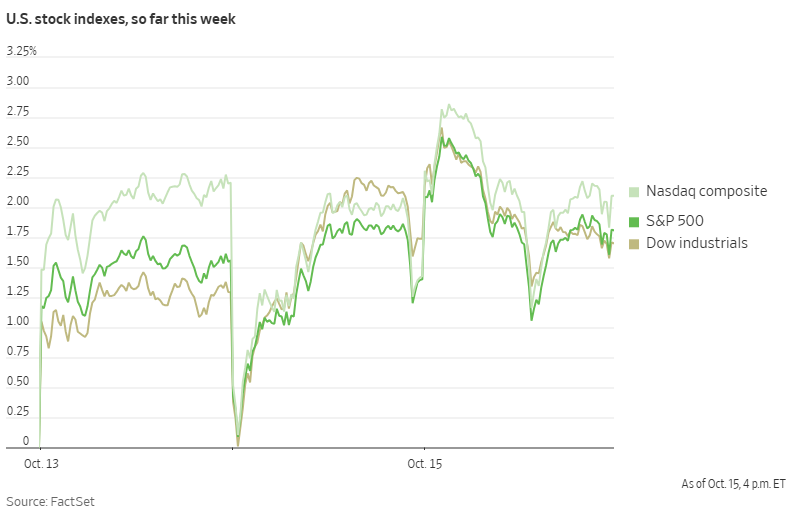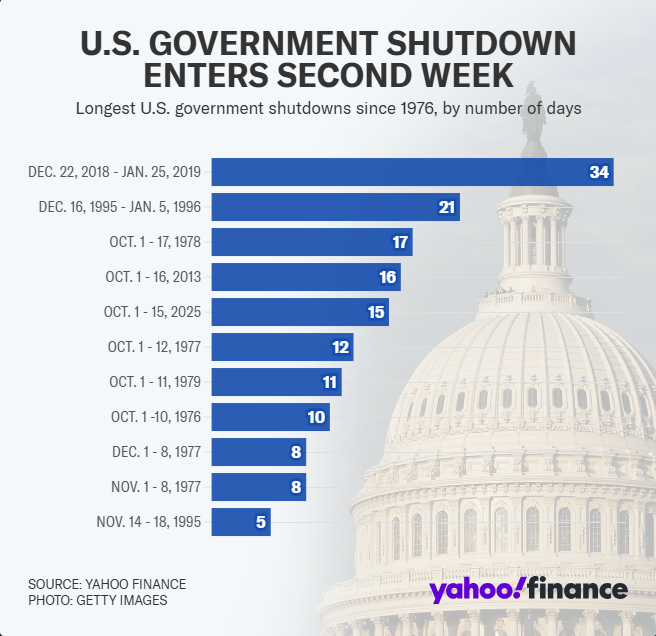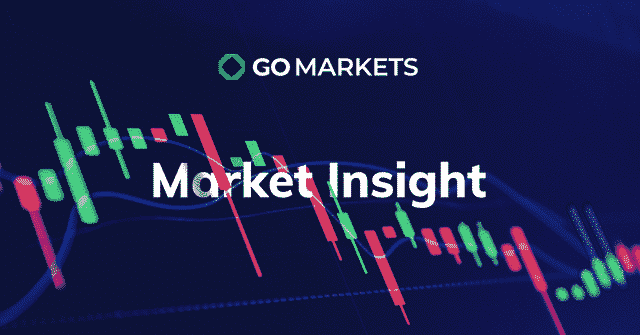Noticias del mercado & perspectivas
Anticípate a los mercados con perspectivas de expertos, noticias y análisis técnico para guiar tus decisiones de trading.

S&P 500 and ASX Rally as Big Banks Drive Markets
Both the S&P 500 and ASX have rallied on the back of stronger-than-expected major bank earnings reports on both sides of the Pacific.
In the US, Bank of America reported a 31% year-over-year increase in earnings per share at $1.06, exceeding Wall Street's estimate of $0.95. Meanwhile, Morgan Stanley delivered a record-breaking quarter with EPS of $2.80, a nearly 49% increase from the same period last year.

On the Australian front, the benchmark ASX 200 leapt 1.03% to 8990.99, with all four major Australian banks playing a major role. CBA closed 1.45% higher, Westpac 1.98%, NAB 1.87%, and ANZ 0.53%.
These strong bank results indicate broader economic strength, despite recent concerns about US-China trade tensions. US Treasury Secretary Scott Bessent emphasised that Washington did not want to escalate trade conflict with China and noted that President Trump is ready to meet Chinese President Xi Jinping in South Korea later this month.
With the third-quarter earnings season just getting underway, these early positive results from financial institutions could prove as the start of continued market strength through to the end of the year.
U.S. Government Shutdown Likely to Last Into November
Washington remains gridlocked as the U.S. enters its 16th day of shutdown. With no signs of compromise on the horizon, it appears increasingly likely the shutdown will extend into November and could even compromise the Thanksgiving holiday season.
Treasury Secretary Scott Bessent has warned "we are starting to cut into muscle here" and estimated "the shutdown may start costing the US economy up to $15 billion a day."
The core issue driving the shutdown is healthcare policy, specifically the expiring Affordable Care Act subsidies. Democrats are demanding these subsidies be extended, while Republicans argue this issue can be addressed separately from government funding.
The Trump administration has taken steps to blunt some of the shutdown's immediate impact, including reallocating funds to pay active-duty soldiers this week and infusing $300 million into food aid programs.
However, House Speaker Mike Johnson has emphasised these are merely "temporary fixes" that likely cannot be repeated at the end of October when the next round of military paychecks is scheduled.

By the end of this week, this shutdown will become the third-longest in U.S. history. If it continues into November 4th, it will surpass the 34-day shutdown of 2018-2019 to become the longest government shutdown ever recorded.
This prolonged shutdown adds another layer of volatility to markets. While previous shutdowns have typically had limited long-term market impacts, the unprecedented length and timing of this closure, combined with its expanding economic toll, warrant closer attention as we move toward November.
Trump Announces Modi Has Agreed to Stop Buying Russian Oil
Yesterday, Trump announced that Indian Prime Minister Narendra Modi has agreed to stop purchasing Russian oil. He stated that Modi assured him India would halt Russian oil imports "within a short period of time," describing it as "a big step" in efforts to isolate Moscow economically.
The announcement comes after months of trade tensions between the US and India. In August, Trump imposed 50% tariffs on Indian exports to the US, doubling previous rates and specifically citing India's Russian oil purchases as a driving factor.

India has been one of Russia's top oil customers alongside China in recent years. Both countries have taken advantage of discounted Russian oil prices since the start of the Ukraine invasion.
Analysis suggests India saved between $2.5 billion to $12.6 billion since 2022 by purchasing discounted Russian crude compared to other sources, helping support its growing economy of 1.4 billion people.
Trump suggested that India's move would help accelerate the end of the Ukraine war, stating: "If India doesn't buy oil, it makes it much easier." He also mentioned his intention to convince China to follow suit: "Now I've got to get China to do the same thing."
The Indian embassy in Washington has not yet confirmed Modi's commitment. Markets will be closely watching for official statements from India and monitoring oil trading patterns in the coming weeks to assess the potential impact on global energy flows and prices.
Chart of the Day - Gold futures CFD (XAUUSD)


A sudden rapid increase in commodity prices, propelled by supply concerns stemming from the Russia and Ukraine conflict, has brought about inflationary pressure and moved future inflation expectation. The increase has also pushed indices into a bear market and caused some volatility in global equities. Nickel, European gas and wheat have all hit record highs on Monday.
Copper, Brent crude oil, aluminium and thermal coal are currently sitting at their highest levels in years. The commodities rally has stirred up fears that inflationary pressures will persist as the price increase works its way through the supply chain and slows down economic growth. The Australian 10-year break-even rate is sitting at 2.48%, its highest level since 2014.
The US 10-year break-even rate increased to 2.86% on Tuesday, its highest level since 2005. The German 10-year break-even rate hit a record high of 2.62%. Break-even rates represent the difference between a nominal bond and an inflation-linked bond of the same maturity, implying the average rate of inflation over a given period of time.
The spike in these rates suggests that the bond market is expecting inflation to be far more persistent than central banks and strategists have been expecting. The fear of Russian energy sanctions has led to heavy selling in the global equity markets. The US Dow Jones, Nasdaq, Euro Stoxx 50 and Germany DAX index have slipped into bear markets as shown from the chart above.
The EU50 and DAX are currently down 20% since their peaks in mid-January. The spike in break-even rates comes after the surge in the price of energy as Brent crude has reached a high of $136 USD a barrel on Monday. This rapid increase in the cost of energy, namely the Brent Oil, is currently making its way through to our local petrol pumps.
As the national average petrol price has climbed to 1.839 per litre. Other commodity prices are also beginning to break into new territory and are likely to drive up the cost of goods further down the supply chain. Nickel recently hit a record high of over $60,000 USD a tonne, as supply risks sparked a short squeeze.
About 7 per cent of the world’s nickel is produced in Russia, with the metal being used to produce stainless steel. It is also a major component of lithium-ion batteries, which are used in electric vehicles. The steady surge in commodity prices and their associated inflation risk has created a dilemma for central banks across the world.
Central banks are trying to manage inflation without curbing growth. All in all, commodity prices are currently on the rise as the conflict between Russia and Ukraine continues. Their prices are now on most investors’ watchlists, as it can affect other markets such as Forex and Indices.
If you would like to take this opportunity to invest and do not yet have a trading account, you can open a GO Markets CFD trading account. Source: GO Markets MT5, TradingView, Globalpetrolprices, AFR


Coinbase Global Inc. (COIN) released its financial results for Q2 after the market close in the US on Tuesday. The company reported revenue that fell short of Wall Street expectations at $808.325 million for Q2 vs. $873.82 million expected. Coinbase reported a loss per share of -$4.98 per share vs. -$2.47 loss per share expected. ''Q2 was a test of durability for crypto companies and a complex quarter overall.
Dramatic market movements shifted user behaviour and trading volume, which impacted transaction revenue, but also highlighted the strength of our risk management program. We are focusing on our top business priorities and more tightly managing expenses.'' ''The decline in crypto asset prices significantly impacted our Q2 financial results, which were consistent with the outlook provided in May. Net revenue was $803 million, down 31% compared to Q1, driven by lower trading volume.
Total operating expenses were $1.9 billion, up 8% compared to Q1. Net loss was $1.1 billion and was heavily impacted by non-cash impairment charges. Absent non-cash impairment charges, net loss would have been $647 million.
Adjusted EBITDA was negative $151 million,'' the company wrote in a letter to shareholders. Coinbase Global Inc. (COIN) chart Share price of Coinbase was down by 10.55% on Tuesday, trading $87.49 a share. The stock fell further in after-hours following the release of the latest financial results, down by around 3%.
Here is how the stock has performed in the past year: 1 month +61.65% 3 months +20.13% Year-to-date -65.26% 1 year -67.49% Coinbase price targets Citigroup $105 DA Davidson $90 Mizuho $42 JMP Securities $205 Atlantic Equities $54 Goldman Sachs $45 JP Morgan $68 Coinbase Global Inc. is the 754 th largest company in the world with a market cap of $22.96 billion. You can trade Coinbase Global Inc. (COIN) and many other stocks from the NYSE, NASDAQ, HKEX and the ASX with GO Markets as a Share CFD. Sources: Coinbase Global Inc., TradingView, MetaTrader 5, Benzinga, CompaniesMarketCap


Fears of slowing growth and weak Chinese data have forced China to ramp up its efforts to stimulate its economy and reassure investors: Record $83 billion injection: China injected a large amount of money in its economy. $83 billion was placed in the country’s financial system to avoid a cash crunch that would add further pressure to an “already” weakening economy. Spending Plans: Amid a raft of measures, China has approved a whopping $125bn of new rail projects over the past month. China is increasing its approvals for new projects and fiscal spending to counteract the slowdown.
Tax Cuts: China has put forward plans for the private sector and small business and is turning to tax cuts as a primary defence for its slowing economy. As uncertainties around tariffs continue, China is helping private companies and small business to obtain financing and increasing consumer spending. As of writing, the GDP (YoY) came at 6.4% from 6.5%, and we expect China’s economy to weaken in the lower range of the 6% mark amid the current external and domestic challenges.
Trade tensions have shaken business and consumer confidence and have further slowed economic growth. Even though there is more optimism on trade talks and higher chances of a truce deal, we expect trade negotiations to be bumpy and lengthy. The real economic implications may become more apparent in the coming months, and this can weigh on risk sentiment.
We expect to continue observing more actions from China during the year. The weak data is also giving room for policymakers to put forward more growth-supportive measures in the near term to stimulate growth and bring stability to its economy. So far, the stimulus actions coupled with positive trade talks helped the Chinese Yuan and the Shanghai Index to climb higher.
After a bruising year, the Index rose by more than 130 points since the beginning of the year.


Buying opportunity on the GBPAUD A short/medium term trading opportunity has arisen on the GBPAUD. The Pound has been weakening after the Bank of England came out last week and forecast that the economy would fall into a 15 month recession later this year. Whilst the bearish sentiment was somewhat of shock it was not totally unexpected.
On the back of this news, the Pound has been falling against most other strong currencies including the USD and the CHF. The most attractive trading opportunity comes in the form of the GBPAUD pair. The AUD has seen some strength on the back of the Chinese CPI figures that came in better than expected.
The AUD, is impacted heavily by the price of commodities. Therefore, it is important to consider the upcoming volatility around the price of commodities. Ultimately, the current economic environment has led to a situation where the GBPAUD is testing recent support zones.
Technical Analysis Using multiple time frame analysis, some interesting patterns have been formed in this pair. Looking at the longest time frame first, the monthly chart it can be seen to break down out of the symmetrical triangle that has been in a consolidation since 2014. This is obviously quite a bearish sign and points to taking a short position.
On the contrary, it is still possible that the price will try and reclaim the triangle. On the weekly chart, the pair is testing a long term support level of 1.72/1.73 AUD. This has remained steady as a support since 2017.
Whilst the price is setting near this level and based on previous levels of structure and support, it is likely that the price will bounce to the top of the range. However it would be best to wait until there is strong buying to indicate a reversal. On the daily chart, the range is even more pronounced and shows that the price has been trading in the range.
The range also provides a short term target of 1.7880 AUD as the next target of resistance. Until a clear break of the range is established buying at the bottom, and selling at the top provides a good risk reward trading strategy.


Beyond Meat Inc. reported their latest financial results for Q4 2021 after the closing bell on Wall Street today. The US plant-based meat substitute producer company fell short of analyst expectations for the last quarter, sending the stock price lower in the after-market hours. The company reported revenue of $100.678 million in Q4 (decrease of 1.2% year-over-year) vs. $101.044 million expected.
Loss per share reported at -$1.27 a share, way above analyst forecast -$0.70 a share. Net revenue for 2021 at $464.7 million – an increase of 14.2% year-over-year. "In 2021 we saw strong growth in our international channel net revenues, as well as sporadic yet promising signs of a resumption of growth in U.S. foodservice channel net revenues as COVID-19 variants peaked and declined. These gains, however, were dampened by what we believe to be a temporary disruption in U.S. retail growth, for our brand and the broader category.
Despite the variability and challenges of the year, we did not deviate from building the foundation for our long-term growth. The investments we made in our team, infrastructure, and capabilities across the U.S., EU, and China, as well as extensive product scaling activities for key strategic partners, weighed heavily on operating expenses and gross margin during a fourth quarter and year that were already impacted by lower than expected volumes. However, we believe these investments will be instrumental in driving our long-term growth," Ethan Brown, Beyond Meat CEO said in a statement following the latest financial results from the company. "As we begin 2022, we are pleased with the progress we are making against our long-term strategy, such as the number of tests and core menu placements recently announced by our global QSR partners.
Though we will continue to invest during 2022, we expect to substantially moderate the growth of our operating expenses as we leverage the building blocks we now have in place to serve our customers, consumers, and markets — bringing forward our exciting and expansive future one delicious serving at a time," Brown added. Beyond Meat Inc. (BYND) chart (Weekly) Shares of Beyond Meat were up by 3.38% on Thursday at $48.64. However, the stock fell sharply in the after-hours – down by around 10%.
Here is how the stock has performed in the past year – 1 Month: -13.37% 3 Month: -35.14% Year-to-date: -24.80% 1 Year: -65.91% Beyond Meat Inc. is the 2973 rd largest company in the world with total market cap of $3.10 billion. You can trade Beyond Meat Inc. (BYND) and many other stocks from the NYSE, NASDAQ, HKEX and the ASX with GO Markets as a Share CFD. Sources: Beyond Meat Inc., TradingView, MetaTrader 5, CompaniesMarketCap


The Buy Now Pay Later, (BNPL) sector has seen a resurgence after a long and brutal sell-off. The reason for, much of the resurgence is not related to any specific catalyst but rather, changing sentiment within the broader market. The sector rose significantly before and during the Covid-19 pandemic.
However, as the pandemic came to an end and consumers returned to traditional forms of purchasing, the BNPL sector began to lose some of its steam. In the last few weeks, the sector has seen a resurgence with many of the heavyweights including ZIP, (ZIP) and Square, (SQ2) seeing large surges in their share prices. Impact of interest rates and recession fears The big issue with the sector was always going to be how would interest rate changes would affect the sector and its model.
The business model generally allows consumers to purchase goods/services in instalments with the requirement to pay interest if the repayments are not met. The interest payments have been a cause for concern from consumers, especially as interest rates have been raised by the Reserve Bank of Australia and other Central Banks. These rate increases created very bearish sentiment for the BNPL sector with ZIP and SQ2 seeing large dips in their share price.
The market also became saturated very quickly, meaning many large institutions and banks created their own BNPL service or bought their own such as Square in the case of their purchase of industry leader Afterpay. This has led to further potential transactions and failed mergers. Specifically, Latitude, (LFS) and its failed acquisition of Humm, (HUM) and ZIP and its failed acquisition of Sezzle, (SZL).
Why the surge? The price of ZIP has seen a very sharp rise. This has been partially because of the short squeeze that has been able to accelerate the price rise.
With so much selling occurring and such a high level of short interest, at some stage, a buying zone had to present itself. Once this zone was established the volume was able to follow through. The market was also buoyed by inflationary pressures easing because of the interest rate hikes.
On both Price Charts below, it can be seen that some kind of ‘bottom in the medium term at least has been found. For ZIP, this was seen at $0.45 and SQ2 at $81. Importantly, and more so for ZIP, the breakout from the bottom was supported by strong buying volume.
This likely indicates that large institutions were behind the reversal. Looking ahead, whilst a ‘bottom’ does seem to be in, the sector is still at the mercy of the overall market and if a recession hits or more bearish sentiment takes over, the BNPL sector may fall again. However, if all the worst outcomes have been priced in already, then long trading/investing opportunities may become apparent.

